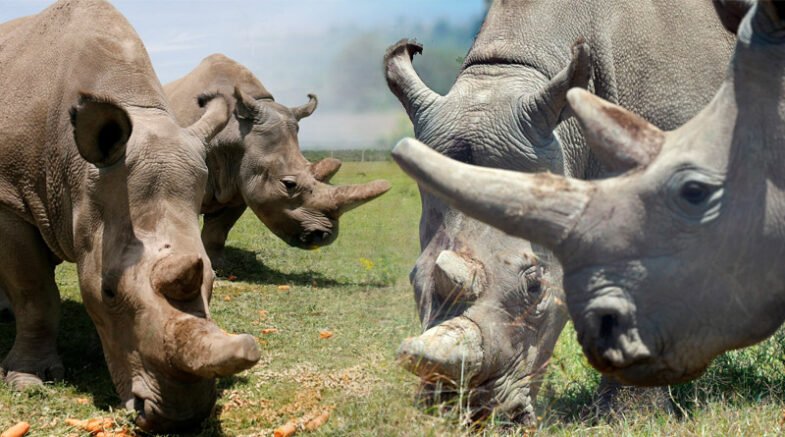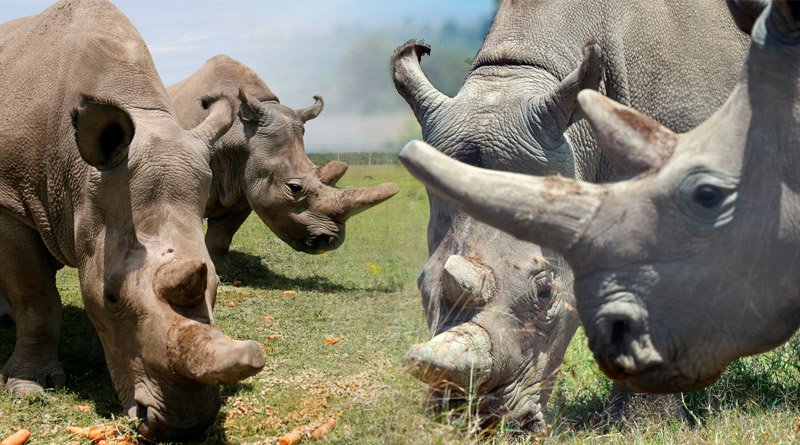The northern white rhino is functionally extinct, but an international group of scientists have been working to bring it back from the brink.

The Ol Pejeta Conservancy in Kenya is home to the last two northern white rhinos left on Earth, Najin and Fatu. They are mother and daughter and cannot reproduce naturally, as there are no males left for them to mate with. As the mercury rises, they will retire to a shady spot and have a siesta, watched over by armed guards.
The northern white rhino is functionally extinct, but an international group of scientists have been working to bring it back from the brink. The BioRescue project involves cutting-edge veterinary science, cell biology and the creation of ‘test tube rhinos’. If all goes according to plan, the pitter-patter of not-so-tiny rhino feet could be just a few years away.
We have hope, says project director and veterinarian Prof. Thomas Hildebrandt of the Leibniz Institute for Zoo and Wildlife Research.
The biggest challenge, however, might not be raising new rhinos; rather, it might be quieting those who think the project should never have been undertaken in the first place. Northern white rhinos were a common sight on the savannahs of eastern and central Africa at the turn of the 20th century, but poaching, habitat destruction, and armed conflict led to a population collapse.
The last northern white rhino, Sudan, died in 2018. Conservationists hoped that the small number of animals left in captivity would be able to kickstart the population, but the rhinos didn’t get the memo. Sudan is one of a number of northern white rhinos who may still be able to produce offspring from beyond the grave, so Hildebrandt and colleagues started to collect and freeze their semen.
Hildebrandt has developed a procedure to stimulate the prostate gland of northern white rhinos, using semen samples stored away from four of the last male rhinos. This was used to artificially inseminate Najin and Fatu, but when the females failed to become pregnant, the team turned to in vitro fertilisation (IVF).
IVF involves the fusion of egg and sperm in a dish to create a ‘test tube embryo’, but rhino eggs are not easy to come by. Hildebrandt developed a method to harvest them, but by the time it was perfected, the only female northern white rhinos remaining were Najin and Fatu. Najin is unable to donate eggs due to an ovarian tumour, leaving 22-year-old Fatu as the only available donor.
Fatu undergoes the procedure roughly once every three months, using an ultrasound-guided needle to puncture her rectal passage and aspirate the immature eggs, known as oocytes.
Hildebrandt and his team have successfully performed the procedure 11 times since 2019, collecting 164 oocytes. The oocytes are flown to a specialist lab in Italy, where they are matured in a bespoke cocktail of chemicals and then used for IVF.
Thawed sperm is injected directly into the egg, which then starts to divide to form an embryo. Just like its human equivalent, it doesn’t always work, but the scientists have still managed to create 24 embryos using eggs from Fatu and sperm from two different males.
Najin and Fatu are unsuitable surrogates for the northern white rhino, as their back legs are too weak to carry a pregnancy. Fortunately, the southern white rhino has a close relative, the 16,000 southern white rhinos living in eastern and southern Africa.
Two of these have been earmarked by the conservancy as surrogates, and Hildebrandt and his team hope to fly to Kenya to implant one of their northern white embryos into one of these surrogates.
Rhino pregnancies last 18 months, and if things go well, the first calf could be born as soon as 2024. However, there is an elephant in the room: all of the northern white embryos created so far come from just three ‘parent’ animals.
To make healthy, genetically diverse embryos, scientists need more eggs and sperm from other, unrelated rhinos. Conservationists have been collecting and freezing living cells from endangered species for 40 years, making them an invaluable research resource and source of raw material for assisted reproductive technologies.
The ‘Frozen Zoo’, run by the San Diego Zoo Wildlife Alliance, contains over 70,000 samples from more than 700 species, including skin cells from 12 different northern white rhinos.
In 2011, cell biologist Dr. Jeanne Loring showed that these skin cells can be ‘reprogrammed’ to become stem cells. In December 2022, a different group of researchers from Japan showed that these stem cells can be coaxed to become the precursors of eggs and sperm.
This suggests that rhino eggs and sperm could be grown in the lab using frozen, decades-old skin cells as the starting point. Scientists have the cells needed to create a viable northern white rhino population, and they have the methods to make it happen.
This could be a game changer, as there is more genetic diversity in the 12 frozen samples than in the entire living population of southern white rhinos. More research is needed to persuade these early egg and sperm cells to morph into mature forms.
The long-term goal is to reintroduce viable populations of northern white rhinos into the wild, where they would act as ecosystem engineers. Rhino dung returns nutrients to the ground, their ticks provide food for birds, and their wallows create and maintain waterholes. However, not everyone is in favour of the northern white rhino’s return.
The BioRescue programme is criticised for being too expensive and not protecting other rhino species, such as the black rhino in Africa or the Indian rhino in Asia. The German science ministry is the primary funder, with a six-year grant of €6 million (approximately £5.25 million).
Critics argue that the project sets a dangerous precedent by suggesting that it is okay to let species dwindle to extinction as long as we can bring them back later. Hildebrandt argues that this is not the case.
Prof. Ronald Sandler from Northeastern University argues that the time has come to let nature run its course and let the northern white rhino go, as to do otherwise would be ‘playing God’.
He argues that traditional conservation methods, such as captive breeding, creating reserves, and preventing poaching, are not so different from undoing human impacts. He also argues that the northern and southern white rhinos are not two separate species, but separate subspecies, which is a term used to denote populations that are genetically similar but geographically distinct.
They went their own separate ways around 80,000 years ago when one population headed north, and another headed south.
The northern white rhino is almost indistinguishable from its southern counterpart, making it difficult to save it. Ecologist Dr. Jason Gilchrist from Edinburgh Napier University argues that it would be more practical to translocate southern white rhinos into the areas where they’d like to be, and let natural selection do its job. He has worked in Africa and helped relocate rhinos from dangerous regions to safe ones.
Hildebrandt argues that evolution could sculpt the southern white rhino into something more closely resembling its northern relative, and that conservation should be in the business of saving subspecies too.
His methods are already being used to collect semen samples from other endangered mammals, and he is working to perfect egg retrieval and embryo implants in elephants. Loring has reprogrammed skin cells from an endangered African monkey species called the drill.
Najin and Fatu are ageing in the meantime. Less than 76 Javan rhinos and 50 Sumatran rhinos are still alive in the wild. Hildebrandt thinks that these techniques might be able to help them and other endangered species. And yet, here we are, he says, “of course, we’d prefer that they didn’t need this kind of intervention in the first place.”
